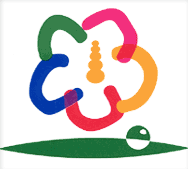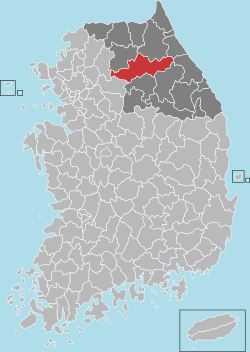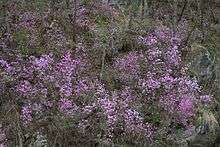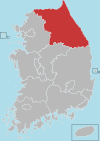Hongcheon County
Hongcheon (Hongcheon-gun) is a county and city in Gangwon Province, South Korea. The city lies on the northern bank of the Hongcheon River, southeast of Chuncheon. The terrain of the county is mainly mountainous and contains hot springs in the Hongcheong River valley.[1][2] The county produces ginseng, maize, and vegetables. As of 2012 the county had a population of 70,401 people (including foreigners) in 29,894 households.[3]
Hongcheon 홍천군 | |
|---|---|
County | |
| Korean transcription(s) | |
| • Hangul | 홍천군 |
| • Hanja | 洪川郡 |
| • Revised Romanization | Hongcheon-gun |
| • McCune-Reischauer | Hongch'ŏn-gun |
 Emblem of Hongcheon | |
 Location in South Korea | |
| Country | |
| Region | Gwandong |
| Administrative divisions | 1 eup, 9 myeon |
| Area | |
| • Total | 1,817.9 km2 (701.9 sq mi) |
| Population (2020) | |
| • Total | 68,389 |
| • Dialect | Gangwon |
History
Hongcheon's historic name was BulRyeokChunHyeon during the rule of Goguryeo. King Gyeongduk of Silla changed the name to YoungHyeon of Sak-Ju, In 1043, it was named Hongcheon during the reign of King In-Jong. Following the independence of the country on 15 August 1945, many administrative changes were made, affecting the jurisdiction of various units under its control.[4]
Korean Federation for Environmental Movement (KFEM) opened an educational facility in Hongcheon in 1995.[5]
Hongcheon County uses an emblem to represent itself as the “County of Culture and Tourism.” The emblem, a simple depiction of a leaf and dew, symbolizes a clean environment, patriotism, and love of one's hometown.[6]
Geography
Hongcheon is located in Gangwon Province. The county, located in the middle of the peninsula, is the largest in Korea with an area of about 1,818 square kilometres (702 sq mi) and is reported to be three times the size of Seoul. It is bounded by Chuncheon city on the north, the Inje County and Yangyang County to the northeast, by Gapyeong County of Gyeonggi-do to the west, by Hoengseong and Pyeongchang counties to the north, and Pyeongchang county to the south. The county is a middle-level mountainous region, an offshoot of the Baegdu mountain range.[7] The eastern end of the mountain range, where Myeonggae village and Nae township are located, runs in an east–west direction for a length of 93.1 km (57.8 mi) The western part of the mountain range which has Dongmak village and Seotown extends over a length of 39.4 km (24.5 mi) in an east–west direction. While the southern part of the hill range covers the Sidong village and the Nam town, the northern part has Jangnam village and Duchon township.[7] The Palbong Mountain (327.4 m) has scenic views of the course of the Hongcheon River; the river forms white sandy banks.[8] The Hongcheon river system which rises the Taebaek mountain watershed, joins the Hongcheon River which forms a small plain area at Seorak-myeon, Gapyeong-gun, Gyeonggi-do. It then flows in to the Cheongpyeong Dam in Gyeonggi Province.[7][9] Gachilbong Sambong Spring is located in Gwangwon-ri, Nae-myeon and originates from the Palbong Mountain;[10] Garyeong Waterfall is located in Waya-ri, Naechon-myeon at the foot of Mt. Baekam (1,099m) which drops through rapids over a height of 50 m. The area is known for medicinal herbs, wild flowers and mountain birds.[11]
The bus terminal provides connections with Gimpo and Incheon airports.[12] A bus ride from Dong Seoul Bus Terminal to Hongcheon is approximately one hour.[13] Naerincheon, a small river, crosses Hongcheon and is the only one in the country which flows north.[14] Nearby is the Daemyung Vivaldi Park Ski World, a ski resort (with 13 ski runs, each with a music theme)[15] and water park in the mountains. Local football club Hongcheon Idu FC play their games at Hongcheon Public Park.
Climate
The climate of Hongcheon county is a humid continental climate. Climatic conditions are considered extreme as its location is away from the sea. The minimum temperature recorded is –28.1℃ in January. The climatic data is given in the table below.
| Climate data for Hongcheon (1981–2010, extremes 1971–present) | |||||||||||||
|---|---|---|---|---|---|---|---|---|---|---|---|---|---|
| Month | Jan | Feb | Mar | Apr | May | Jun | Jul | Aug | Sep | Oct | Nov | Dec | Year |
| Record high °C (°F) | 14.1 (57.4) |
19.8 (67.6) |
23.9 (75.0) |
32.5 (90.5) |
35.0 (95.0) |
36.2 (97.2) |
38.3 (100.9) |
41.0 (105.8) |
34.5 (94.1) |
29.1 (84.4) |
25.6 (78.1) |
16.7 (62.1) |
41.0 (105.8) |
| Average high °C (°F) | 1.6 (34.9) |
5.1 (41.2) |
11.2 (52.2) |
19.3 (66.7) |
24.2 (75.6) |
28.0 (82.4) |
29.5 (85.1) |
30.2 (86.4) |
25.9 (78.6) |
19.9 (67.8) |
11.3 (52.3) |
4.1 (39.4) |
17.5 (63.5) |
| Daily mean °C (°F) | −5.5 (22.1) |
−2.3 (27.9) |
3.7 (38.7) |
10.8 (51.4) |
16.3 (61.3) |
21.0 (69.8) |
24.0 (75.2) |
24.2 (75.6) |
18.7 (65.7) |
11.6 (52.9) |
4.1 (39.4) |
−2.6 (27.3) |
10.3 (50.5) |
| Average low °C (°F) | −11.5 (11.3) |
−8.4 (16.9) |
−2.6 (27.3) |
3.1 (37.6) |
9.4 (48.9) |
15.3 (59.5) |
20.0 (68.0) |
20.1 (68.2) |
14.0 (57.2) |
5.9 (42.6) |
−1.4 (29.5) |
−8.0 (17.6) |
4.7 (40.5) |
| Record low °C (°F) | −28.1 (−18.6) |
−24.8 (−12.6) |
−16.8 (1.8) |
−8.0 (17.6) |
0.2 (32.4) |
4.7 (40.5) |
9.9 (49.8) |
8.5 (47.3) |
0.4 (32.7) |
−6.4 (20.5) |
−14.7 (5.5) |
−22.8 (−9.0) |
−28.1 (−18.6) |
| Average precipitation mm (inches) | 20.4 (0.80) |
25.7 (1.01) |
45.6 (1.80) |
66.2 (2.61) |
105.2 (4.14) |
140.6 (5.54) |
397.0 (15.63) |
316.3 (12.45) |
178.9 (7.04) |
49.5 (1.95) |
40.9 (1.61) |
19.1 (0.75) |
1,405.4 (55.33) |
| Average precipitation days (≥ 0.1 mm) | 6.2 | 6.0 | 7.6 | 7.1 | 8.4 | 9.8 | 14.9 | 13.9 | 8.0 | 5.4 | 7.0 | 6.4 | 100.7 |
| Average snowy days | 7.4 | 5.7 | 3.6 | 0.4 | 0.0 | 0.0 | 0.0 | 0.0 | 0.0 | 0.1 | 2.1 | 5.7 | 24.7 |
| Average relative humidity (%) | 69.5 | 66.1 | 62.5 | 57.8 | 63.9 | 69.3 | 77.4 | 77.2 | 75.8 | 72.7 | 70.7 | 70.8 | 69.5 |
| Mean monthly sunshine hours | 161.1 | 168.7 | 195.7 | 214.6 | 224.8 | 204.0 | 159.3 | 175.7 | 175.8 | 182.8 | 145.7 | 150.5 | 2,163.7 |
| Percent possible sunshine | 52.6 | 55.4 | 52.8 | 54.3 | 51.1 | 46.2 | 35.5 | 41.7 | 47.1 | 52.5 | 47.8 | 50.4 | 48.6 |
| Source: Korea Meteorological Administration[16][17][18] (percent sunshine and snowy days)[19] | |||||||||||||
Flora and fauna

Daisy fleabane, a native plant of North America, was inadvertently introduced to Korea in the 1990s and is found in Hongcheon County also. A strange spot on its leaf was found in daisy fleabanes in June 2011. This was tested in the laboratory and found to be caused by a pest identified as Septoria erigerontis.[20]
Rice cultivation
The dominant crop grown in the country is called the Sura rice. The county, with its widely varying temperatures between day and night times, and with clean and un polluted water, provides an ideal environmental condition ideal to grow this crop which is considered to be of very high quality with cooked rice retaining its taste for much longer than other species of rice. It is grown in 38% of the land under cultivation in the county. It is also disease resistant and can be stored for a long time.[21]
Culture
The county is noted for its beef production. With favorable climatic conditions, the male calves (bred by artificial insemination) are the source of the beef. They are fed alcohol-fermented feed which is reported to reduce the cholesterol content and give flavor to the beef. The calves are raised for minimum of 27 months.[22]
Cultural festivals celebrated in Hongcheon include the Chal Oksusu (Corn) Festival, Mugunga (Hibiscus) Festival, and Ginseng Festival.[23] The Mugunghwa Festival honors the memory of Namgung Eok, a statesman and journalist from Hongcheon.[24] The Hongcheon Ginseng Festival, first held in 2003, is held annually in October to celebrate the medicinal properties of ginseng, considered a miracle medicine in Korea. Traditional Taekkyeon and Dudrak performances are part of the festivities.[13][25] Previously, the county celebrated Choi Seung-hee Dance Festival in honor of a dancer who developed modern forms of traditional folk dances, but because she spent the latter years of her life in North Korea, she is no longer celebrated.
Symbol Mark
Among the five colors of Mugunghwa petals, blue symbolizes the spirit of the county people, green symbolizes the unpolluted natural environment. Pink symbolizes the fragrance of flowers. Yellow symbolizes the peace of Hongcheon. Red symbolizes the passion of Hongcheon.

The center of the flower represents the cohesive power of the Hongcheon people and the green water droplets in the lower part represent a clean earth.
Character
The name of the character is Mugungi. The Muguni character is a symbol of Hongcheon.
The water droplets representing the nature of Hongcheon were expressed to the face. The high-tech antenna on the right expressed its meaning as a character leading the information age.[26]
Notable sites
The Korean peninsula has been subject to archaeological excavations for establishing obsidian (a naturally occurring volcanic glass formed as an extrusive igneous rock) at many Paleolithic sites. One such site excavated is located in Hongcheon county, known as Hahwageri III. Several samples collected from the site have been subject to carbon dating. In the first cultural layer, out of the two layers established during the excavations, the finds consists of microliths of obsidian and quartz crystal which are embedded in microblade cores. In addition, arrowheads, cores, anvils, hammerstones and pecking tools have also been recovered, apart from a large cache of obsidian artifacts.[27]
The Suta Temple of Mt Gongjak is a Buddhist shrine at the foot of the Gongjak Mountain which appears like a peacock spreading its wings and its flora consists of azalea and ancient pine trees. It is a national monument that was built in 708, in stone, by the Buddhist priest WonHyo during the reign of King SeongDeok, the 33rd King of Silla.[28]
Notable people
It is the birthplace of Lee Young-Pyo, who plays for the South Korea national football team. He also plays for Vancouver Whitecaps FC of Major League Soccer.
References
- Yŏn, Ha-chʻŏng (1981). Primary health care in Korea: an approach to evaluation. Korea Development Institute. p. 41. ISBN 978-0-8248-0763-4. Retrieved 10 June 2013.
- Korea Now. Korea Herald. January 2003. p. 47. Retrieved 10 June 2013.
- "Population". Website of Gangwon Province. 31 December 2012. Archived from the original on 2 June 2013. Retrieved 23 June 2013.
- "The history of hongcheon - gun". Official website of Hongcheon Gangwon. Archived from the original on 1 August 2012. Retrieved 13 June 2013.
- Lee, Yok-Shiu F.; So, Alvin Y. (January 1999). Asia's Environmental Movements: Comparative Perspectives. M.E. Sharpe. p. 111. ISBN 978-1-56324-909-9. Retrieved 10 June 2013.
- "County Flag". Official website of Hongcheon Gangwon. Archived from the original on 1 August 2012. Retrieved 23 June 2013.
- "General". Official website of Hongcheon Gangwon. Archived from the original on 27 February 2014. Retrieved 13 June 2013.
- "1st Spot : Palbong-san Mountain". Official website of Hongcheon Gangwon. Archived from the original on 4 August 2012. Retrieved 13 June 2013.
- Ahn, Y.K.; Ryan, Y.S. (September 1988). "Epidemiological studies on Metagonimus infection along the Hongcheon river, Kangwon province". Kisaengchunghak Chapchi. 26 (3): 207–213. PMID 12811049.
- "Gachilbong Sambong Spring". Official website of Hongcheon Gangwon. Archived from the original on 1 August 2012. Retrieved 13 June 2013.
- "Garyeong Waterfall". Official website of Hongcheon Gangwon. Archived from the original on 2 August 2012. Retrieved 13 June 2013.
- "Hongcheon Bus Schedules".
- "Hongcheon Ginseng Festival". KOREA TOURISM ORGANIZATION.
- Frommer's Short Cuts (27 June 2012). Gangwon-do, South Korea: Frommer's ShortCuts. John Wiley & Sons. pp. 77–. ISBN 978-1-118-47010-7.
- Kendall Hamilton, ed. (November 2005). Ski. pp. 182–. ISSN 0037-6159.
- "평년값자료(1981–2010) 홍천(212)" (in Korean). Korea Meteorological Administration. Retrieved 2011-05-02.
- "기후자료 극값(최대값) 전체년도 일최고기온 (℃) 최고순위, 홍천(212)" (in Korean). Korea Meteorological Administration. Retrieved 1 August 2018.
- "기후자료 극값(최대값) 전체년도 일최저기온 (℃) 최고순위, 홍천(212)" (in Korean). Korea Meteorological Administration. Retrieved 1 August 2018.
- "Climatological Normals of Korea" (PDF). Korea Meteorological Administration. 2011. p. 499 and 649. Archived from the original (PDF) on 7 December 2016. Retrieved 10 February 2017.
- "First Report of Leaf Spot Caused by Septoria erigerontis on Erigeron strigosus in Korea" (pdf) (in Korean). Journal of the American Phytopathological Society. Retrieved 12 June 2013.
- "Surassal:Distinctive Features". Official website of Hongcheon Gangwon. Archived from the original on 24 June 2013. Retrieved 23 June 2013.
- "2013 National Brand Awards Winners". Agrafood.co.kr. Archived from the original on 11 March 2016. Retrieved 11 June 2013.
- "Culturafestival". Official website of Hongcheon Gangwon. Archived from the original on 30 June 2010. Retrieved 13 June 2013.
- "Mugunghwa Festival". Official website of Hongcheon Gangwon. Archived from the original on 16 June 2013. Retrieved 13 June 2013.
- "Ginseng Festival". Official website of Hongcheon Gangwon. Archived from the original on 3 August 2012. Retrieved 13 June 2013.
- "캐릭터 - 홍천군청". www.hongcheon.gangwon.kr. Retrieved 2019-03-16.
- "Pixe Provenancing Of Obsidian Artefacts From Paleolithic Sites In Korea". Ejournal of the Kangwon National University. Archived from the original on 16 May 2013. Retrieved 11 June 2013.
- "Suta Temple of Gongjak Mt". Official website of Hongcheon Gangwon. Archived from the original on 2 August 2012. Retrieved 13 June 2013.
